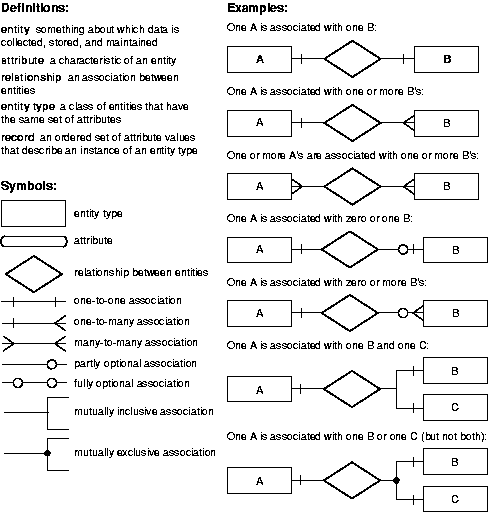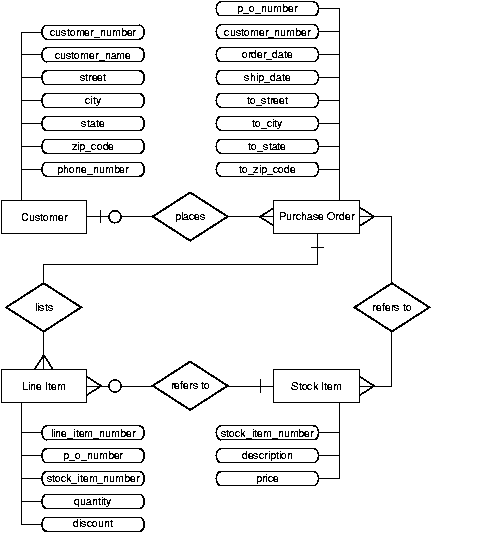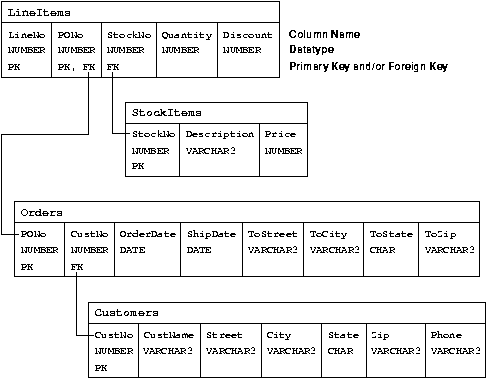Release 2 (9.2)
Part Number A96659-01
Home |
Book List |
Contents |
Index |
 Master Index |
 Feedback |
| Oracle9i Java Stored Procedures Developer's Guide Release 2 (9.2) Part Number A96659-01 |
|
This chapter demonstrates the building of a Java stored procedures application. The example is based on a simple business activity: managing customer purchase orders. By following along from design to implementation, you learn enough to start writing your own applications.
The objective is to develop a simple system for managing customer purchase orders. First, you must identify the business entities involved and their relationships. To do that, you draw an entity-relationship (E-R) diagram by following the rules and examples given in Figure 5-1.

As Figure 5-2 illustrates, the basic entities in this example are customers, purchase orders, line items, and stock items.

A Customer has a one-to-many relationship with a Purchase Order because a customer can place many orders, but a given purchase order can be placed by only one customer. The relationship is optional because zero customers might place a given order (it might be placed by someone not previously defined as a customer).
A Purchase Order has a many-to-many relationship with a Stock Item because a purchase order can refer to many stock items, and a stock item can be referred to by many purchase orders. However, you do not know which purchase orders refer to which stock items.
Therefore, you introduce the notion of a Line Item. A Purchase Order has a one-to-many relationship with a Line Item because a purchase order can list many line items, but a given line item can be listed by only one purchase order.
A LineItem has a many-to-one relationship with a StockItem because a line item can refer to only one stock item, but a given stock item can be referred to by many line items. The relationship is optional because zero line items might refer to a given stock item.
Next, you must devise a schema plan. To do that, you decompose the E-R diagram into the following database tables:
For example, you assign Customer attributes to columns in the table Customers.
Figure 5-3 depicts the relationships between tables. The E-R diagram showed that a line item has a relationship with a purchase order and with a stock item. In the schema plan, you establish these relationships using primary and foreign keys.
A primary key is a column (or combination of columns) whose values uniquely identify each row in a table. A foreign key is a column (or combination of columns) whose values match the primary key in some other table. For example, column PONo in table LineItems is a foreign key matching the primary key in table Orders. Every purchase order number in column LineItems.PONo must also appear in column Orders.PONo.

Next, you create the database tables required by the schema plan. You begin by defining the table Customers, as follows:
CREATE TABLE Customers ( CustNo NUMBER(3) NOT NULL, CustName VARCHAR2(30) NOT NULL, Street VARCHAR2(20) NOT NULL, City VARCHAR2(20) NOT NULL, State CHAR(2) NOT NULL, Zip VARCHAR2(10) NOT NULL, Phone VARCHAR2(12), PRIMARY KEY (CustNo) );
The table Customers stores all the information about customers. Essential information is defined as NOT NULL. For example, every customer must have a shipping address. However, the table Customers does not manage the relationship between a customer and his or her purchase order. So, that relationship must be managed by the table Orders, which you define as:
CREATE TABLE Orders ( PONo NUMBER(5), Custno NUMBER(3) REFERENCES Customers, OrderDate DATE, ShipDate DATE, ToStreet VARCHAR2(20), ToCity VARCHAR2(20), ToState CHAR(2), ToZip VARCHAR2(10), PRIMARY KEY (PONo) );
The E-R diagram in Figure 5-2 showed that line items have a relationship with purchase orders and stock items. The table LineItems manages these relationships using foreign keys. For example, the foreign key (FK) column StockNo in the table LineItems references the primary key (PK) column StockNo in the table StockItems, which you define as:
CREATE TABLE StockItems ( StockNo NUMBER(4) PRIMARY KEY, Description VARCHAR2(20), Price NUMBER(6,2)) );
The table Orders manages the relationship between a customer and purchase order using the FK column CustNo, which references the PK column CustNo in the table Customers. However, the table Orders does not manage the relationship between a purchase order and its line items. So, that relationship must be managed by the table LineItems, which you define as:
CREATE TABLE LineItems ( LineNo NUMBER(2), PONo NUMBER(5) REFERENCES Orders, StockNo NUMBER(4) REFERENCES StockItems, Quantity NUMBER(2), Discount NUMBER(4,2), PRIMARY KEY (LineNo, PONo) );
Next, you consider the operations needed in a purchase order system, then you write appropriate Java methods. In a simple system based on the tables defined in the previous section, you need methods for registering customers, stocking parts, entering orders, and so on. You implement these methods in the Java class POManager, as follows:
import java.sql.*; import java.io.*; import oracle.jdbc.*; public class POManager { public static void addCustomer (int custNo, String custName, String street, String city, String state, String zipCode, String phoneNo) throws SQLException { String sql = "INSERT INTO Customers VALUES (?,?,?,?,?,?,?)"; try { Connection conn = DriverManager.getConnection("jdbc:default:connection:"); PreparedStatement pstmt = conn.prepareStatement(sql); pstmt.setInt(1, custNo); pstmt.setString(2, custName); pstmt.setString(3, street); pstmt.setString(4, city); pstmt.setString(5, state); pstmt.setString(6, zipCode); pstmt.setString(7, phoneNo); pstmt.executeUpdate(); pstmt.close(); } catch (SQLException e) {System.err.println(e.getMessage());} } public static void addStockItem (int stockNo, String description, float price) throws SQLException { String sql = "INSERT INTO StockItems VALUES (?,?,?)"; try { Connection conn = DriverManager.getConnection("jdbc:default:connection:"); PreparedStatement pstmt = conn.prepareStatement(sql); pstmt.setInt(1, stockNo); pstmt.setString(2, description); pstmt.setFloat(3, price); pstmt.executeUpdate(); pstmt.close(); } catch (SQLException e) {System.err.println(e.getMessage());} } public static void enterOrder (int orderNo, int custNo, String orderDate, String shipDate, String toStreet, String toCity, String toState, String toZipCode) throws SQLException { String sql = "INSERT INTO Orders VALUES (?,?,?,?,?,?,?,?)"; try { Connection conn = DriverManager.getConnection("jdbc:default:connection:"); PreparedStatement pstmt = conn.prepareStatement(sql); pstmt.setInt(1, orderNo); pstmt.setInt(2, custNo); pstmt.setString(3, orderDate); pstmt.setString(4, shipDate); pstmt.setString(5, toStreet); pstmt.setString(6, toCity); pstmt.setString(7, toState); pstmt.setString(8, toZipCode); pstmt.executeUpdate(); pstmt.close(); } catch (SQLException e) {System.err.println(e.getMessage());} } public static void addLineItem (int lineNo, int orderNo, int stockNo, int quantity, float discount) throws SQLException { String sql = "INSERT INTO LineItems VALUES (?,?,?,?,?)"; try { Connection conn = DriverManager.getConnection("jdbc:default:connection:"); PreparedStatement pstmt = conn.prepareStatement(sql); pstmt.setInt(1, lineNo); pstmt.setInt(2, orderNo); pstmt.setInt(3, stockNo); pstmt.setInt(4, quantity); pstmt.setFloat(5, discount); pstmt.executeUpdate(); pstmt.close(); } catch (SQLException e) {System.err.println(e.getMessage());} } public static void totalOrders () throws SQLException { String sql = "SELECT O.PONo, ROUND(SUM(S.Price * L.Quantity)) AS TOTAL " + "FROM Orders O, LineItems L, StockItems S " + "WHERE O.PONo = L.PONo AND L.StockNo = S.StockNo " + "GROUP BY O.PONo"; try { Connection conn = DriverManager.getConnection("jdbc:default:connection:"); PreparedStatement pstmt = conn.prepareStatement(sql); ResultSet rset = pstmt.executeQuery(); printResults(rset); rset.close(); pstmt.close(); } catch (SQLException e) {System.err.println(e.getMessage());} } static void printResults (ResultSet rset) throws SQLException { String buffer = ""; try { ResultSetMetaData meta = rset.getMetaData(); int cols = meta.getColumnCount(), rows = 0; for (int i = 1; i <= cols; i++) { int size = meta.getPrecision(i); String label = meta.getColumnLabel(i); if (label.length() > size) size = label.length(); while (label.length() < size) label += " "; buffer = buffer + label + " "; } buffer = buffer + "\n"; while (rset.next()) { rows++; for (int i = 1; i <= cols; i++) { int size = meta.getPrecision(i); String label = meta.getColumnLabel(i); String value = rset.getString(i); if (label.length() > size) size = label.length(); while (value.length() < size) value += " "; buffer = buffer + value + " "; } buffer = buffer + "\n"; } if (rows == 0) buffer = "No data found!\n"; System.out.println(buffer); } catch (SQLException e) {System.err.println(e.getMessage());} } public static void checkStockItem (int stockNo) throws SQLException { String sql = "SELECT O.PONo, O.CustNo, L.StockNo, " + "L.LineNo, L.Quantity, L.Discount " + "FROM Orders O, LineItems L " + "WHERE O.PONo = L.PONo AND L.StockNo = ?"; try { Connection conn = DriverManager.getConnection("jdbc:default:connection:"); PreparedStatement pstmt = conn.prepareStatement(sql); pstmt.setInt(1, stockNo); ResultSet rset = pstmt.executeQuery(); printResults(rset); rset.close(); pstmt.close(); } catch (SQLException e) {System.err.println(e.getMessage());} } public static void changeQuantity (int newQty, int orderNo, int stockNo) throws SQLException { String sql = "UPDATE LineItems SET Quantity = ? " + "WHERE PONo = ? AND StockNo = ?"; try { Connection conn = DriverManager.getConnection("jdbc:default:connection:"); PreparedStatement pstmt = conn.prepareStatement(sql); pstmt.setInt(1, newQty); pstmt.setInt(2, orderNo); pstmt.setInt(3, stockNo); pstmt.executeUpdate(); pstmt.close(); } catch (SQLException e) {System.err.println(e.getMessage());} } public static void deleteOrder (int orderNo) throws SQLException { String sql = "DELETE FROM LineItems WHERE PONo = ?"; try { Connection conn = DriverManager.getConnection("jdbc:default:connection:"); PreparedStatement pstmt = conn.prepareStatement(sql); pstmt.setInt(1, orderNo); pstmt.executeUpdate(); sql = "DELETE FROM Orders WHERE PONo = ?"; pstmt = conn.prepareStatement(sql); pstmt.setInt(1, orderNo); pstmt.executeUpdate(); pstmt.close(); } catch (SQLException e) {System.err.println(e.getMessage());} } }
Next, you use the command-line utility loadjava to upload your Java stored procedures into the Oracle database, as follows:
> loadjava -u scott/tiger@myPC:1521:orcl -v -r -t POManager.java initialization complete loading : POManager creating : POManager resolver : resolver ( ("*" scott) ("*" public) ("*" -)) resolving: POManager
Recall that option -v enables verbose mode, that option -r compiles uploaded Java source files and resolves external references in the classes, and that option -t tells loadjava to connect to the database using the client-side JDBC Thin driver.
Next, you must publish your Java stored procedures in the Oracle data dictionary. To do that, you write call specs, which map Java method names, parameter types, and return types to their SQL counterparts.
The methods in the Java class POManager are logically related, so you group their call specs in a PL/SQL package. First, you create the package spec, as follows:
CREATE OR REPLACE PACKAGE po_mgr AS PROCEDURE add_customer (cust_no NUMBER, cust_name VARCHAR2, street VARCHAR2, city VARCHAR2, state CHAR, zip_code VARCHAR2, phone_no VARCHAR2); PROCEDURE add_stock_item (stock_no NUMBER, description VARCHAR2, price NUMBER); PROCEDURE enter_order (order_no NUMBER, cust_no NUMBER, order_date VARCHAR2, ship_date VARCHAR2, to_street VARCHAR2, to_city VARCHAR2, to_state CHAR, to_zip_code VARCHAR2); PROCEDURE add_line_item (line_no NUMBER, order_no NUMBER, stock_no NUMBER, quantity NUMBER, discount NUMBER); PROCEDURE total_orders; PROCEDURE check_stock_item (stock_no NUMBER); PROCEDURE change_quantity (new_qty NUMBER, order_no NUMBER, stock_no NUMBER); PROCEDURE delete_order (order_no NUMBER); END po_mgr;
Then, you create the package body by writing call specs for the Java methods:
CREATE OR REPLACE PACKAGE BODY po_mgr AS PROCEDURE add_customer (cust_no NUMBER, cust_name VARCHAR2, street VARCHAR2, city VARCHAR2, state CHAR, zip_code VARCHAR2, phone_no VARCHAR2) AS LANGUAGE JAVA NAME 'POManager.addCustomer(int, java.lang.String, java.lang.String, java.lang.String, java.lang.String, java.lang.String, java.lang.String)'; PROCEDURE add_stock_item (stock_no NUMBER, description VARCHAR2, price NUMBER) AS LANGUAGE JAVA NAME 'POManager.addStockItem(int, java.lang.String, float)'; PROCEDURE enter_order (order_no NUMBER, cust_no NUMBER, order_date VARCHAR2, ship_date VARCHAR2, to_street VARCHAR2, to_city VARCHAR2, to_state CHAR, to_zip_code VARCHAR2) AS LANGUAGE JAVA NAME 'POManager.enterOrder(int, int, java.lang.String, java.lang.String, java.lang.String, java.lang.String, java.lang.String, java.lang.String)'; PROCEDURE add_line_item (line_no NUMBER, order_no NUMBER, stock_no NUMBER, quantity NUMBER, discount NUMBER) AS LANGUAGE JAVA NAME 'POManager.addLineItem(int, int, int, int, float)'; PROCEDURE total_orders AS LANGUAGE JAVA NAME 'POManager.totalOrders()'; PROCEDURE check_stock_item (stock_no NUMBER) AS LANGUAGE JAVA NAME 'POManager.checkStockItem(int)'; PROCEDURE change_quantity (new_qty NUMBER, order_no NUMBER, stock_no NUMBER) AS LANGUAGE JAVA NAME 'POManager.changeQuantity(int, int, int)'; PROCEDURE delete_order (order_no NUMBER) AS LANGUAGE JAVA NAME 'POManager.deleteOrder(int)'; END po_mgr;
Now, you can call your Java stored procedures from the top level and from database triggers, SQL DML statements, and PL/SQL blocks. To reference the stored procedures in the package po_mgr, you must use dot notation.
From an anonymous PL/SQL block, you might start the new purchase order system by stocking parts, as follows:
BEGIN po_mgr.add_stock_item(2010, 'camshaft', 245.00); po_mgr.add_stock_item(2011, 'connecting rod', 122.50); po_mgr.add_stock_item(2012, 'crankshaft', 388.25); po_mgr.add_stock_item(2013, 'cylinder head', 201.75); po_mgr.add_stock_item(2014, 'cylinder sleeve', 73.50); po_mgr.add_stock_item(2015, 'engine bearning', 43.85); po_mgr.add_stock_item(2016, 'flywheel', 155.00); po_mgr.add_stock_item(2017, 'freeze plug', 17.95); po_mgr.add_stock_item(2018, 'head gasket', 36.75); po_mgr.add_stock_item(2019, 'lifter', 96.25); po_mgr.add_stock_item(2020, 'oil pump', 207.95); po_mgr.add_stock_item(2021, 'piston', 137.75); po_mgr.add_stock_item(2022, 'piston ring', 21.35); po_mgr.add_stock_item(2023, 'pushrod', 110.00); po_mgr.add_stock_item(2024, 'rocker arm', 186.50); po_mgr.add_stock_item(2025, 'valve', 68.50); po_mgr.add_stock_item(2026, 'valve spring', 13.25); po_mgr.add_stock_item(2027, 'water pump', 144.50); COMMIT; END;
Then, you register your customers:
BEGIN po_mgr.add_customer(101, 'A-1 Automotive', '4490 Stevens Blvd', 'San Jose', 'CA', '95129', '408-555-1212'); po_mgr.add_customer(102, 'AutoQuest', '2032 America Ave', 'Hayward', 'CA', '94545', '510-555-1212'); po_mgr.add_customer(103, 'Bell Auto Supply', '305 Cheyenne Ave', 'Richardson', 'TX', '75080', '972-555-1212'); po_mgr.add_customer(104, 'CarTech Auto Parts', '910 LBJ Freeway', 'Dallas', 'TX', '75234', '214-555-1212'); COMMIT; END;
Next, you enter purchase orders placed by various customers:
BEGIN po_mgr.enter_order(30501, 103, '14-SEP-1998', '21-SEP-1998', '305 Cheyenne Ave', 'Richardson', 'TX', '75080'); po_mgr.add_line_item(01, 30501, 2011, 5, 0.02); po_mgr.add_line_item(02, 30501, 2018, 25, 0.10); po_mgr.add_line_item(03, 30501, 2026, 10, 0.05); po_mgr.enter_order(30502, 102, '15-SEP-1998', '22-SEP-1998', '2032 America Ave', 'Hayward', 'CA', '94545'); po_mgr.add_line_item(01, 30502, 2013, 1, 0.00); po_mgr.add_line_item(02, 30502, 2014, 1, 0.00); po_mgr.enter_order(30503, 104, '15-SEP-1998', '23-SEP-1998', '910 LBJ Freeway', 'Dallas', 'TX', '75234'); po_mgr.add_line_item(01, 30503, 2020, 5, 0.02); po_mgr.add_line_item(02, 30503, 2027, 5, 0.02); po_mgr.add_line_item(03, 30503, 2021, 15, 0.05); po_mgr.add_line_item(04, 30503, 2022, 15, 0.05); po_mgr.enter_order(30504, 101, '16-SEP-1998', '23-SEP-1998', '4490 Stevens Blvd', 'San Jose', 'CA', '95129'); po_mgr.add_line_item(01, 30504, 2025, 20, 0.10); po_mgr.add_line_item(02, 30504, 2026, 20, 0.10); COMMIT; END;
Finally, in SQL*Plus, after redirecting output to the SQL*Plus text buffer, you might call the Java method totalOrders as follows:
SQL> SET SERVEROUTPUT ON SQL> CALL dbms_java.set_output(2000); ... SQL> CALL po_mgr.total_orders(); PONO TOTAL 30501 1664 30502 275 30503 4149 30504 1635 Call completed.
|
 Copyright © 2000, 2002 Oracle Corporation. All Rights Reserved. |
|